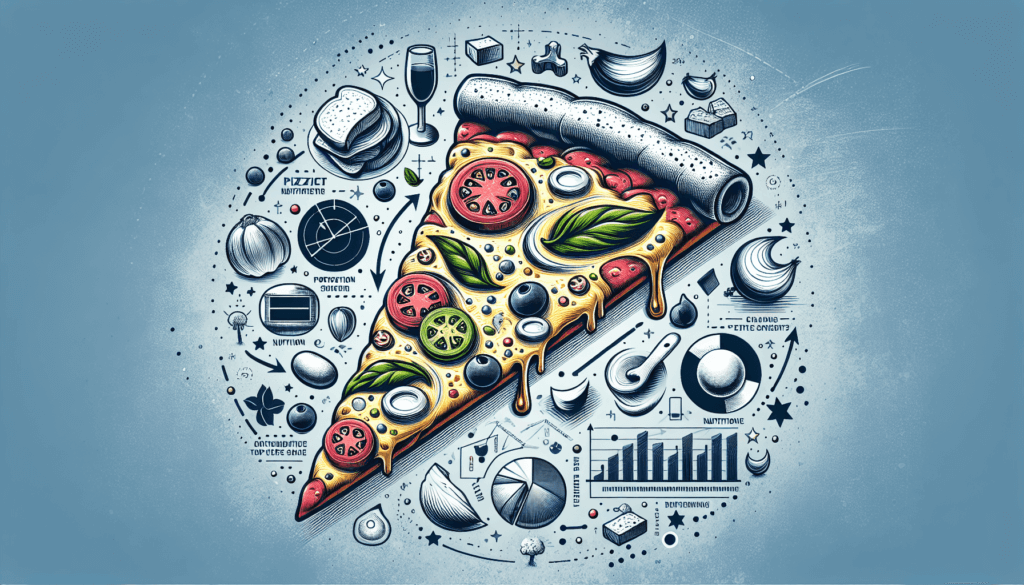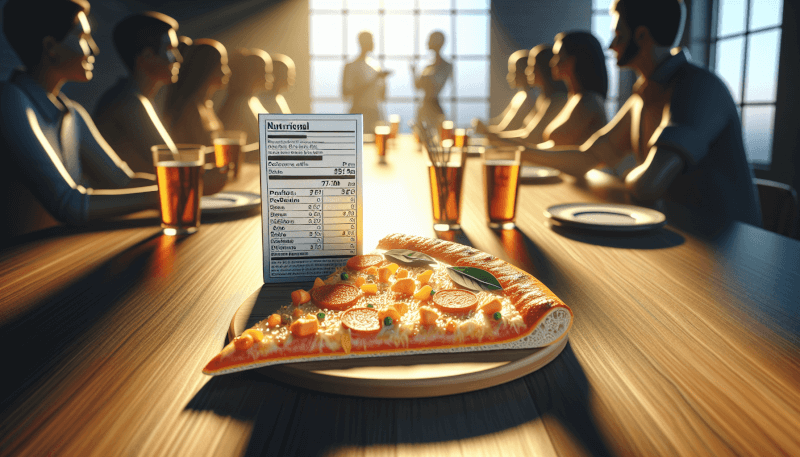Imagine this scenario: you find yourself at a pizza party, surrounded by friends and the mouthwatering scent of freshly baked pies. As you debate which slice to reach for, a question crosses your mind: is one slice of pizza enough for dinner? In this article, we’ll explore the age-old dilemma of pizza portion sizes and dig into the factors that might determine whether you should indulge in a single slice or go for a second. Get ready for a slice of pizza wisdom that will leave you craving for more!
Nutritional Value of Pizza
When it comes to the nutritional value of pizza, it’s important to consider both its macronutrients and micronutrients. Macronutrients refer to the three main components of our diet: carbohydrates, proteins, and fats. Pizza typically consists of a dough crust made from carbohydrates, a sauce made from tomatoes, and toppings that can include proteins like cheese and meats, as well as fats such as olive oil. These macronutrients provide the body with energy and help to build and repair tissues.
In terms of micronutrients, pizza can vary depending on the specific ingredients used. However, common micronutrients found in pizza include vitamins and minerals such as vitamin C, vitamin A, calcium, and iron. These micronutrients are essential for many bodily processes, including immune function, bone health, and oxygen transport.
Macronutrients
Pizza generally provides a good source of carbohydrates, which are necessary for sustained energy throughout the day. Carbohydrates are the body’s main source of fuel, providing the energy needed for physical activities and brain function. The dough crust in pizza is typically made from refined flour, which is high in carbohydrates but low in fiber. Including whole grain or whole wheat crust options can increase the fiber content and provide added health benefits.
Protein is another important macronutrient found in pizza. Cheese and meat toppings are common sources of protein, which is essential for muscle growth, repair, and maintenance. Protein also helps to keep you feeling fuller for longer, reducing the temptation to overeat.
Fats in pizza primarily come from the cheese and any added oils. While fats are necessary for a balanced diet, it’s important to consume them in moderation. Opting for lower-fat cheese options or reducing the amount of added oil can help mitigate your overall fat intake.
Micronutrients
The micronutrient content of pizza can vary depending on the toppings and sauce used. For example, tomatoes, which are commonly used in pizza sauce, are a rich source of vitamin C and provide beneficial antioxidants. Additionally, cheese, which is often a major ingredient in pizza, contains calcium and phosphorus, which are important for bone health. Keep in mind that the nutrient content can vary significantly between different types and brands of pizza, so it’s always a good idea to check the label if you’re conscious about specific micronutrient values.
Calorie Content
Calories are a measurement of energy, and it’s important to consider the calorie content of the pizza you consume. The total calorie content of pizza depends on various factors, including the crust thickness, the type of cheese used, the quantity and type of toppings, and any additional oils or sauces. On average, a slice of pizza can range from 200 to 400 calories, but it’s worth noting that this can vary significantly depending on the size and ingredients of the slice.
Factors to Consider
When determining whether one slice of pizza is enough for dinner, there are several factors to take into account. These factors include individual caloric needs, the type of pizza, the toppings, and any accompaniments that may be consumed alongside it.
Individual Caloric Needs
Everyone has different caloric needs based on their age, gender, weight, height, and activity levels. It’s essential to consider your individual needs when deciding whether one slice of pizza is enough for dinner. A slice of pizza can provide a substantial amount of energy, but it may not be sufficient on its own to meet all of your daily caloric needs. It’s important to ensure that you are consuming an appropriate number of calories to maintain a healthy weight and support your activity levels.
Type of Pizza
The type of pizza you choose can significantly impact its nutritional value and how filling the slice will be. Thin-crust pizzas are generally lower in calories compared to deep-dish or stuffed crust options. If you’re looking to enjoy a slice of pizza without consuming an excessive number of calories, opting for a thin-crust version may be a better choice.
Toppings
The toppings you choose can also affect the nutritional value of your pizza. While cheese and meat toppings can provide protein, they can also add extra calories and saturated fat. Including vegetables as toppings can be a great way to increase the fiber and nutrient content of your slice. Vegetables like bell peppers, onions, spinach, and mushrooms can add flavor, texture, and essential vitamins to your meal.
Accompaniments
Consider any accompaniments or side dishes you plan to have alongside your slice of pizza. Things like garlic bread, breadsticks, or a side of fries can increase the overall calorie content of your meal. Opting for healthier side options like a salad or steamed vegetables can help balance out your meal and add more nutrients.

Satisfying Hunger
Determining whether one slice of pizza is enough to satisfy your hunger depends on various factors. These factors include the size of the slice compared to your personal hunger levels and the satiety factors of pizza.
Size Comparison
The size of the slice is an important aspect to consider when determining whether it will be enough to satisfy your hunger. Pizza slices can vary in size, from small individual slices to larger slices that are part of a whole pizza. If you’re only having one slice, ensure it is a substantial size that will provide enough nourishment and energy for your needs.
Satiety Factors
Several factors contribute to the satiety of a slice of pizza. Protein and fiber are known to increase feelings of fullness and satisfaction. Therefore, choosing a slice of pizza with protein-rich toppings like chicken, lean ham, or even vegetarian options like tofu can help increase its satiety factor. Additionally, including more vegetables on your slice can add bulk and fiber, making you feel fuller for longer. Consider these factors when selecting your perfect slice of pizza.
Health Considerations
While pizza can be a delicious and satisfying meal, it’s important to consider some health considerations, particularly when it comes to portion control, sodium intake, and processed ingredients.
Portion Control
Portion control is crucial when enjoying pizza as part of a balanced diet. Consuming too many slices or an oversized slice can lead to overeating and contribute to weight gain. It’s important to listen to your body’s hunger and fullness cues and practice mindful eating. Pay attention to portion sizes and try to fill your plate with a variety of other nutritious foods, such as salad or vegetables, to create a well-rounded meal.
Sodium Intake
Pizza can be high in sodium, mainly due to the processed ingredients often used, such as cured meats, cheese, and sauces. High sodium intake has been linked to increased blood pressure and other health issues. To reduce your sodium intake, consider choosing lower-sodium options, such as homemade pizza with fresh ingredients, or choose vegetable toppings instead of sodium-rich meats. Additionally, be mindful of other high-sodium accompaniments, like dipping sauces or processed side dishes.
Processed Ingredients
Many commercial pizzas contain processed ingredients that may not be as beneficial for your health. Processed meats like pepperoni, sausage, and bacon can be high in saturated fats and sodium. Opt for leaner options like chicken or turkey, or even vegetarian toppings like mushrooms and onions. Similarly, choosing pizza with whole food ingredients and a minimal number of additives can help prioritize your health.

Alternative Dinner Options
While pizza can be a convenient and delicious dinner option, sometimes you may want to explore other alternatives that offer a balanced and nutritious meal. Here are some ideas for balanced meals and healthier swaps.
Balanced Meal Ideas
Grilled chicken or fish with roasted vegetables and quinoa: This meal provides lean protein, fiber, and a variety of vitamins and minerals from the vegetables, along with a serving of whole grains.
Stir-fried tofu and mixed vegetables with brown rice: This plant-based meal offers protein from tofu, fiber from the vegetables, and complex carbohydrates from brown rice.
Baked salmon with steamed broccoli and sweet potato: Salmon is high in omega-3 fatty acids, which are beneficial for heart health. Pairing it with nutrient-dense vegetables and sweet potatoes offers a well-balanced meal.
Healthier Swaps
If you’re craving the flavors of pizza but want a healthier alternative, consider these swaps:
Portobello mushroom pizza: Use large Portobello mushroom caps as a pizza base and top them with marinara sauce, cheese, and your favorite veggies. Bake until the cheese melts, and you have a delicious and lower-calorie alternative.
Cauliflower crust pizza: Replace the traditional dough crust with a cauliflower crust for a gluten-free and lower-carb option. Top it with your favorite sauce, cheese, and toppings, and enjoy.
Whole wheat pita pizza: Use whole wheat pita bread as a base and add your desired toppings. This provides a smaller portion size compared to traditional pizza, making it easier to control your calorie intake.
By exploring these alternative options, you can still enjoy a satisfying and nutritious meal while diversifying your dinner choices.
In conclusion, whether one slice is enough for dinner depends on several factors such as individual caloric needs, the type of pizza, toppings, and accompaniments. Understanding the nutritional value of pizza, practicing portion control, and considering healthier alternatives can help you make informed decisions about incorporating pizza into your diet. Remember, enjoying a slice of pizza can still be part of a balanced and enjoyable meal when eaten mindfully and in moderation.


